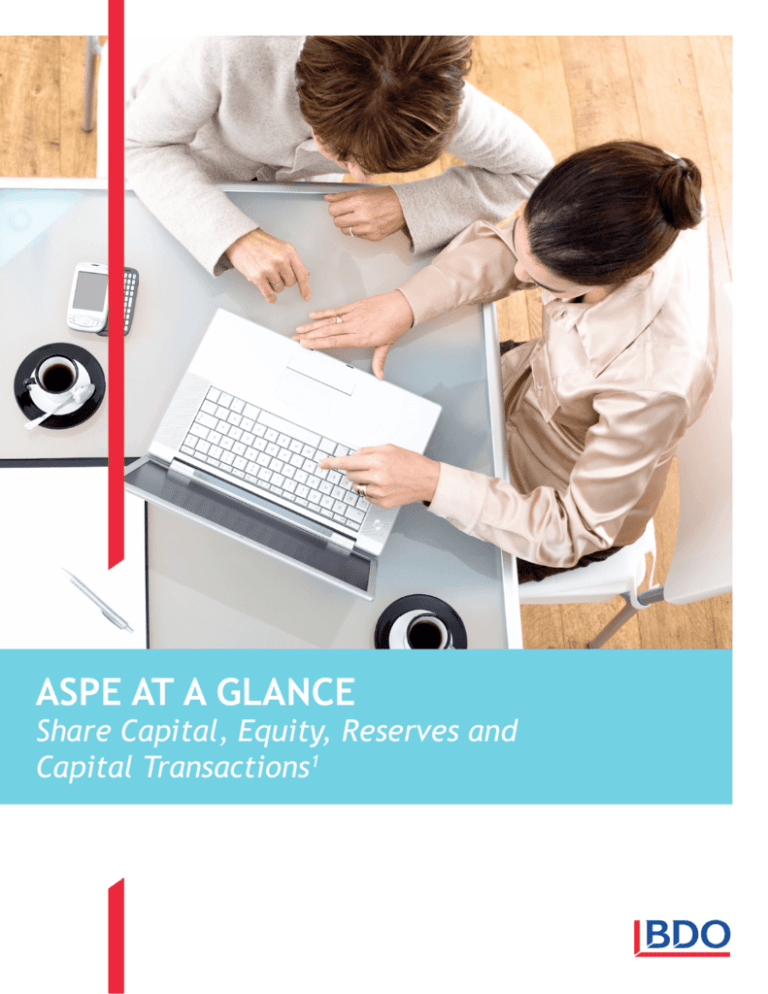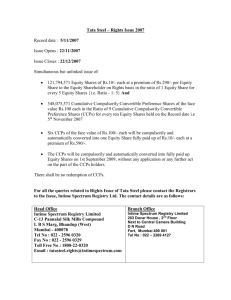ASPE at a Glance: Share Capital, Equity, Reserves
advertisement

ASPE AT A GLANCE Share Capital, Equity, Reserves and Capital Transactions1 December 2014 Share Capital, Equity, Reserves and Capital Transactions1 Effective Date Fiscal years beginning on or after January 1, 2011 EQUITY CONTRIBUTED SURPLUS RETAINED EARNINGS NON-CONTROLLING INTEREST CAPITAL TRANSACTIONS The residual interest in the assets of the enterprise after deducting all of its liabilities. • Comprises amounts paid in by equityholders. • Contributed surplus in the form of surplus paid in by equityholders includes premiums on shares issued, any portion of the proceeds of issue of shares without par value not allocated to share capital, gain on forfeited shares, proceeds arising from shares donated by equityholders, credits resulting from redemption or conversion of shares at less than the amount set up as share capital, and any other contribution by equityholders in excess of amounts allocated to share capital. • Comprises the accumulated balance of income less losses arising from the operation of the business, after taking into account dividends, refundable taxes and other amounts that may properly be charged or credited thereto. • When the accumulation is a negative figure, “deficit" is a suitable description. The equity in a subsidiary not attributable, directly or indirectly, to a parent. Include items such as: • Changes in capital, including premiums, discounts and expenses relating to the issue, redemption or cancellation of share capital; • Gains or losses: • On purchase and resale by a company of its own issued common shares; or • on purchase and cancellation by a company of its own issued common shares; • Contributions by owners or others; • Transfers to and from reserves; • Dividend distributions (including stock dividends); and • Taxes arising at the time of changes in shareholder status or share capital transactions. • Paragraph .22 of Section 3856, Financial Instruments, determines whether a transaction involving a financial instrument is a capital transaction. ACQUISITION OR REDEMPTION OF SHARES When a company redeems or acquires its own shares, the difference between the cost and the par, stated or assigned value is a capital transaction and is excluded from the determination of net income. ACQUISITION OF SHARES REDEMPTION OR CANCELLATION OF SHARES RESALE OF ACQUIRED SHARES DIVIDENDS When a company acquires its own shares, the shares are carried at cost and shown as a deduction from shareholders' equity until cancelled or resold. • When a company redeems its own shares, or cancels its own shares that it has acquired, and the cost of such shares is equal to or greater than their par, stated or assigned value, the cost is allocated as follows: • To share capital, in an amount equal to the par, stated or assigned value of the shares (based on the average pershare amount in such account for that class of share at the transaction date); • Any excess, to contributed surplus to the extent that contributed surplus was created by a net excess of proceeds over cost on cancellation or resale of shares of the same class; • Any excess, to contributed surplus in an amount equal to the pro rata share of the portion of contributed surplus that arose from transactions, other than those in (b) above, in the same class of shares; and • Any excess, to retained earnings. When a company resells shares that it has acquired, any excess of the proceeds over cost is credited to contributed surplus; any deficiency is charged to contributed surplus to the extent that a previous net excess from resale or cancellation of shares of the same class is included therein, otherwise to retained earnings. When a company has acquired its own shares and such shares have not been cancelled, any dividends otherwise payable with respect to these shares are treated as a reduction of dividends and are not be reflected as income by the company. 1 • When a company redeems its own shares, or cancels its own shares that it has acquired, and the cost of such shares is below their par, stated or assigned value, the cost is allocated as follows: • To share capital in an amount equal to the par, stated or assigned value of the shares (based on the average pershare amount in such account for that class of share at the transaction date); and • The difference, to contributed surplus. Includes Sections 3240 – Share Capital, 3251 – Equity, 3260 – Reserves, and 3610 – Capital Transactions. ACQUISITION OF A COMPANY – PUSH-DOWN ACCOUNTING RESERVES • Use of the term "reserve" is limited to an amount that, though not required to meet a liability or contingency known or admitted or a decline in value that has already occurred as at the balance sheet date, has been appropriated from retained earnings or other surplus: • At the discretion of management (e.g. reserve for future decline in inventory values, reserve for general contingencies, reserve for future plant extension); or • Pursuant to the requirements of a statute, the instrument of incorporation or by-laws of a company or a trust indenture, or other agreement (e.g. sinking fund reserve, general reserve, preferred stock redemption reserve). • Reserves are created or increased only by appropriations of retained earnings or other surplus. They are not set up or increased by charges made in arriving at net income for the period. • Regardless of how a reserve was originally created, all reductions in reserves are returned to retained earnings or other surplus and no charges are made against the reserves that would relieve the income account of charges that are to be taken into account in determining the net income for the period. PRESENTATION EQUITY • An enterprise presents separately changes in equity for the period arising from each of the following: • Net income, showing separately the total amounts attributable to owners of the parent and to non-controlling interests; • Other changes in retained earnings; • Changes in contributed surplus; • Changes in share capital; • Changes in reserves; and • Other changes in equity. • An enterprise presents separately the following components of equity: • Retained earnings; • Contributed surplus; • Share capital; • Reserves; • Non-controlling interests; and • Other components of equity. • A company presents a separate component of equity for each category of equity that is of a different nature. • The basic classification must not be distorted by compliance with statutory requirements as to special designations of certain items of equity. An appropriate description or explanation must be added when statutory designations deviate from accepted usage in financial statements or are otherwise inadequate. • Charges against contributed surplus are restricted to instances when that disposition is clearly warranted by the circumstances, such as: • A charge that is the direct opposite of a credit previously carried to contributed surplus; or • The elimination or reduction of a deficit, when made with the approval of the shareholders. • Share purchase loans receivable are presented as deductions from shareholders' equity unless there is substantial evidence that the borrower, not the enterprise, is at risk for any decline in the price of the shares and there is reasonable assurance that the enterprise will collect the full amount of the loan in cash. RESERVES CAPITAL TRANSACTIONS • Shown as part of shareholders' equity with the source from which they were created (i.e., retained earnings or contributed surplus) indicated. • Changes in reserves during the period are presented separately in the financial statements. Excluded from determination of net income and presented separately in the statement to which they related (at least for the year in which the transactions occur). National Office 36 Toronto Street Suite 600 Toronto ON M5C 2C5 800 805 9544 www.bdo.ca This publication has been carefully prepared, but it has been written in general terms and should be seen as broad guidance only. The publication cannot be relied upon to cover specific situations and you should not act, or refrain from acting, upon the information contained therein without obtaining specific professional advice. Please contact BDO Canada LLP to discuss these matters in the context of your particular circumstances. BDO Canada LLP, its partners, employees and agents do not accept or assume any liability or duty of care for any loss arising from any action taken or not taken by anyone in reliance on the information in this publication or for any decision based on it. BDO Canada LLP, a Canadian limited liability partnership, is a member of BDO International Limited, a UK company limited by guarantee, and forms part of the international BDO network of independent member firms. BDO is the brand name for the BDO network and for each of the BDO Member Firms.






